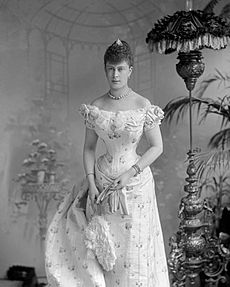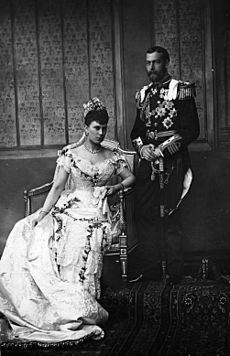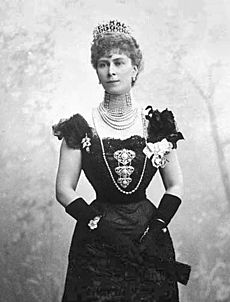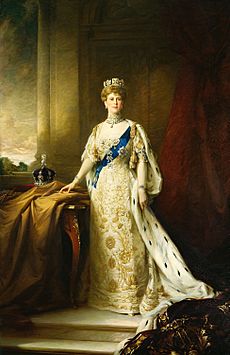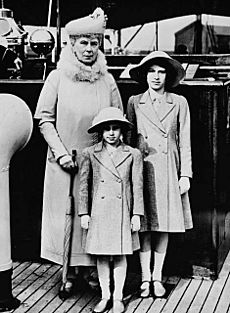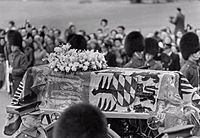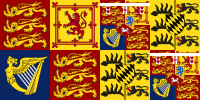Mary of Teck facts for kids
Quick facts for kids Mary of Teck |
|||||
|---|---|---|---|---|---|
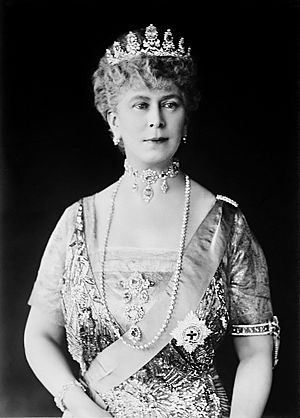
Formal portrait, 1920s
|
|||||
| Queen consort of the United Kingdom and the British Dominions, Empress consort of India |
|||||
| Tenure | 6 May 1910 – 20 January 1936 | ||||
| Coronation | 22 June 1911 | ||||
| Imperial Durbar | 12 December 1911 | ||||
| Born | Princess Victoria Mary of Teck 26 May 1867 Kensington Palace, London |
||||
| Died | 24 March 1953 (aged 85) Marlborough House, London |
||||
| Burial | 31 March 1953 North Nave Aisle, St George's Chapel, Windsor Castle |
||||
| Spouse | |||||
| Issue | |||||
|
|||||
| House | Teck | ||||
| Father | Francis, Duke of Teck | ||||
| Mother | Princess Mary Adelaide of Cambridge | ||||
| Signature |  |
||||
Mary of Teck (born Victoria Mary Augusta Louise Olga Pauline Claudine Agnes; 26 May 1867 – 24 March 1953) was the Queen of the United Kingdom and its Dominions. She was also the Empress of India. She held these titles from 1910 to 1936 as the wife of King George V.
Mary was born and grew up in the United Kingdom. Her father was Francis, Duke of Teck, a German nobleman. Her mother was Princess Mary Adelaide of Cambridge, a granddaughter of King George III. Mary was a minor member of the British royal family. People often called her "May" because she was born in May.
When she was 24, she was engaged to Prince Albert Victor, Duke of Clarence and Avondale. He was the eldest son of the Prince of Wales. Sadly, he died suddenly six weeks after their engagement. The next year, she became engaged to Albert Victor's younger brother, George. He later became King. Before George became king, Mary was known as the Duchess of York, then Duchess of Cornwall, and finally Princess of Wales.
As Queen consort from 1910, Mary supported her husband, King George V. She helped him through World War I, his health problems, and big political changes. After George died in 1936, she became the queen mother. Her oldest son, Edward VIII, became king. But he gave up the throne later that year. He wanted to marry Wallis Simpson, an American woman who had been divorced twice. Mary then supported her second son, George VI, until he died in 1952. Mary herself died the next year, in 1953. This was during the reign of her granddaughter, Elizabeth II. An ocean liner, a warship, and a university were named after her.
Contents
Early Life and Family
Princess Victoria Mary of Teck was born on 26 May 1867. She was born at Kensington Palace in London. This was the same room where Queen Victoria had been born 48 years earlier. Queen Victoria visited the baby and said she was "a very fine one".
Mary's father was Francis, Duke of Teck. Her mother was Princess Mary Adelaide of Cambridge. Mary's mother was a granddaughter of King George III.
Mary was baptized on 27 July 1867. From a young age, her family and friends called her "May". This was because she was born in May.
Growing Up and Education
Mary's childhood was "merry but fairly strict". She was the oldest of four children and the only daughter. She learned to be wise and firm by helping her three younger brothers solve their arguments. They often played with their cousins, the children of the Prince of Wales.
Mary grew up at Kensington Palace and White Lodge. White Lodge was given to her family by Queen Victoria. Mary was taught at home by her mother and a governess. Her mother, the Duchess of Teck, spent a lot of time with her children. She also involved Mary in charity work, like visiting poor neighborhoods.
Mary's father, the Duke of Teck, did not have much money. In 1883, his family moved abroad to save money. They traveled around Europe, visiting relatives. They stayed in Florence, Italy, for a while. Mary enjoyed visiting art galleries and museums there. She could speak English, German, and French very well.
In 1885, the family returned to London. Mary was very close to her mother. She helped organize parties and social events. She was also close to her aunt, the Grand Duchess of Mecklenburg-Strelitz. Mary wrote to her aunt every week.
Engagements and Marriage
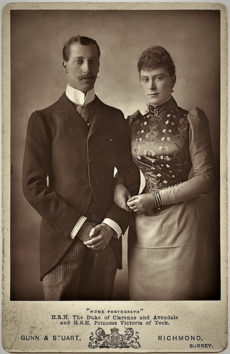
In 1886, Mary was introduced to society as a debutante. She was the only unmarried British princess not directly descended from Queen Victoria. This made her a good match for Prince Albert Victor, Duke of Clarence and Avondale. He was the eldest son of the Prince of Wales.
On 3 December 1891, Albert Victor proposed to Mary, and she accepted. Queen Victoria liked Mary's strong character and sense of duty. Sadly, Albert Victor died six weeks later from the flu.
Albert Victor's brother, Prince George, Duke of York, became closer to Mary during their shared time of sadness. Queen Victoria still thought Mary would be a good wife for a future king. In May 1893, George proposed, and Mary accepted. They fell deeply in love, and their marriage was very happy. George wrote to Mary every day they were apart.
Mary married Prince George, Duke of York, on 6 July 1893. The wedding was at the Chapel Royal in St James's Palace. The new Duke and Duchess of York lived at York Cottage on the Sandringham Estate. They also had apartments in St James's Palace. York Cottage was a simple home for royals, but George liked its quiet life.
Family Life
Mary and George had six children: Edward, Albert, Mary, Henry, George, and John.
Like many upper-class families then, the children were cared for by nannies. One nanny was fired for being rude. Another nanny was replaced because she was unkind to the children. She would pinch Edward and Albert so they would cry and be sent back to her. After this was discovered, a kind assistant, Charlotte Bill, took over.
Mary and George sometimes seemed distant as parents. They did not notice the nanny's unkindness at first. Their youngest son, Prince John, lived in a private farm with his nanny. This was perhaps to keep his epilepsy private. Despite her serious public image, Mary was a caring mother. She comforted her children when their father was strict.
Edward later wrote about his mother. He remembered her soft voice and her cultivated mind. He said she was proud of her children and carefully recorded their childhood milestones.
As Duke and Duchess of York, George and Mary performed many public duties. In 1897, Mary became the patron of the London Needlework Guild. She was very skilled at embroidery herself.
On 22 January 1901, Queen Victoria died. Mary's father-in-law became King Edward VII. For most of that year, George and Mary were known as the "Duke and Duchess of Cornwall and York". They went on a long tour of the British Empire. They visited places like Australia, New Zealand, and Canada. No royal had ever done such a big tour before. Mary cried at the thought of leaving her children for so long. The children stayed with their grandparents.
Princess of Wales
On 9 November 1901, George was made Prince of Wales. The family moved their London home to Marlborough House. As Princess of Wales, Mary traveled with her husband. They visited Austria-Hungary and Württemberg in 1904. The next year, Mary gave birth to her last child, John. It was a difficult birth, and John had breathing problems.
From October 1905, the Prince and Princess of Wales went on another eight-month tour, this time to India. The children were again left with their grandparents. After this tour, they went to Spain for a royal wedding. Soon after returning to Britain, Mary and George went to Norway for another coronation.
Queen and Empress Consort
On 6 May 1910, King Edward VII died. Mary's husband became king, and she became Queen consort. Her husband asked her to choose one of her two official names, Victoria Mary. She chose Mary, so she wouldn't have the same name as Queen Victoria. She was the first British queen consort born in Britain since Catherine Parr.
Mary was crowned with her husband on 22 June 1911 at Westminster Abbey. Later that year, the new King and Queen traveled to India. They attended the Delhi Durbar on 12 December 1911. They toured India as Emperor and Empress of India. They returned to Britain in February.
At the start of her time as Queen, Mary had some disagreements with her mother-in-law, Queen Alexandra. They were friendly, but Alexandra was stubborn. She wanted to be more important than Mary at Edward VII's funeral. She also took a long time to leave Buckingham Palace. And she kept some royal jewels that should have gone to the new Queen.
World War I and Aftermath
During World War I, Queen Mary made the palace save food. She visited wounded soldiers in hospitals. This was very difficult for her emotionally. After three years of war against Germany, there was strong anti-German feeling in Britain. The Russian Imperial Family was refused safety in Britain. News of the Russian Tsar giving up his throne made some people in Britain want to get rid of their own monarchy. The war ended in 1918.
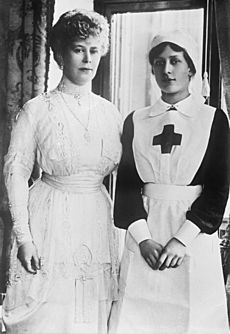
Two months after the war ended, Queen Mary's youngest son, John, died at age thirteen. She wrote about her shock and sadness in her diary. She said, "our poor darling little Johnnie had passed away suddenly... The first break in the family circle is hard to bear."
Mary continued to strongly support her husband. She helped him with his speeches. She used her knowledge of history to advise him on royal matters. He valued her wisdom and good judgment. She remained calm and confident during her public duties after the war. This was a time of social unrest and independence movements in Ireland and India.
In the late 1920s, King George V became very ill with lung problems. This was made worse by his heavy smoking. Queen Mary took great care of him. In 1928, a doctor said that the Queen had saved the King's life. In 1935, King George V and Queen Mary celebrated their silver jubilee. There were celebrations across the British Empire. In his speech, George publicly praised his wife. He told his speechwriter, "I cannot trust myself to speak of the Queen when I think of all I owe her."
Queen Mother
King George V died on 20 January 1936. Queen Mary's oldest son became King Edward VIII. She was then known as Her Majesty Queen Mary.
Within a year, Edward wanted to marry Wallis Simpson, an American woman who had been divorced twice. This led to him giving up the throne. Mary did not approve of divorce, as it was against the rules of the Church of England. She thought Simpson was not suitable to be a queen. Edward gave up the throne after being advised that he could not be king and marry Simpson.
Mary loved her son, but she could not understand why he would give up his royal duties for personal feelings. She refused to meet Wallis Simpson after the abdication. Mary felt it was her duty to support her second son, Prince Albert, Duke of York. Albert became king after Edward's abdication and took the name George VI. When Mary attended his coronation, she was the first British dowager queen to do so. Edward's abdication did not stop her love for him, but she never changed her mind about his actions.
Mary was interested in raising her granddaughters, Princesses Elizabeth and Margaret. She took them on trips to art galleries and museums in London. In May 1939, Mary was in a car crash. Her car overturned, but she only had minor injuries.
During World War II, King George VI wanted his mother to leave London for safety. She moved to Badminton House in Gloucestershire with her niece. Her belongings were moved in seventy pieces of luggage. Her household of fifty-five servants lived there until after the war. Queen Mary even had old ivy removed from the house walls because she thought it was ugly.
From Badminton, she supported the war effort. She visited troops and factories. She was known to offer rides to soldiers she saw on the roads. In 1942, her youngest surviving son, Prince George, Duke of Kent, died in a plane crash during active service. Mary returned to Marlborough House in June 1945, after the war in Europe ended.
Collector of Royal Items
Mary loved collecting objects and pictures connected to royalty. She often paid high prices for jewels from other royal families. For example, she bought the Cambridge Emeralds for almost three times their estimated value. In 1924, the famous architect Sir Edwin Lutyens created Queen Mary's Dolls' House for her collection of miniature items.
She has sometimes been criticized for how she collected items for the Royal Collection. She would sometimes tell hosts that she admired something they owned, hoping they would donate it.
Her deep knowledge of the Royal Collection helped her find items that had been lost over the years. The royal family had lent out many pieces. Once she found unreturned items through old lists, she would write to the people holding them and ask for them back. Mary also ordered many jewelry gifts, like rings for her ladies-in-waiting when they got engaged.
Death and Legacy
In 1952, King George VI died. He was the third of Queen Mary's children to die before her. Her oldest granddaughter, Princess Elizabeth, became Queen Elizabeth II. The death of her third child deeply affected Mary. She said, "I have lost three sons through death, but I have never been privileged to be there to say a last farewell to them."
Mary died on 24 March 1953 in her sleep. She was 85 years old. This was ten weeks before her granddaughter's coronation. She had made it known that if she died, the coronation should not be postponed. Her body was displayed at Westminster Hall. Many people came to see her coffin. She is buried next to her husband in St George's Chapel, Windsor Castle.
Many places and buildings have been named in her honor. These include Queen Mary University of London, Queen Mary Reservoir in Surrey, and Queen Mary College in Lahore.
Sir Henry "Chips" Channon wrote that she was "magnificent, humorous, worldly, in fact nearly sublime, though cold and hard. But what a grand Queen."
Images for kids
See also
 In Spanish: María de Teck para niños
In Spanish: María de Teck para niños



